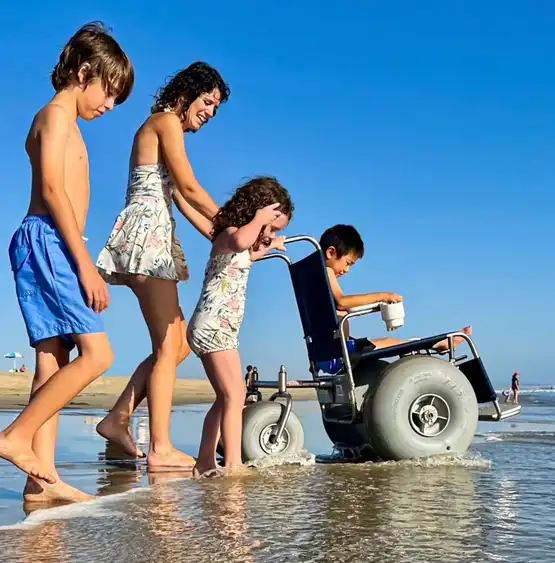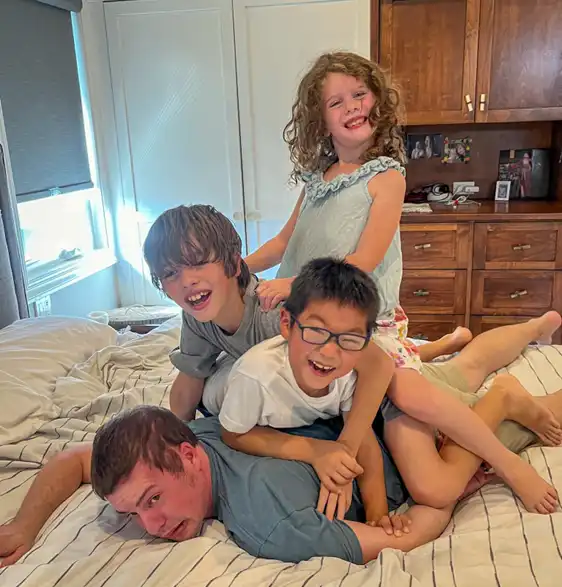
Listen to this Article
The world is full of barriers for wheelchair users and the mobility disabled. Everywhere you look there are stairs, or rocks, or fallen trees, or curbs or potholes or something that keeps you from being able to easily navigate the world around you. The more we travel, however, the more I come to realize that these aren’t the barriers that keep us home. In fact, there are often simple ways around all of these obstacles. The biggest obstacle isn’t a physical barrier, it isn’t visible, and it isn’t even standing between our children and the world… it’s in front of us, as parents.
Often, the number one thing keeping us from experiencing the world and living life to its fullest is our own fear of the unknown.
When I first found out my middle son would never walk, I envisioned us being trapped in the playroom for the rest of our lives. I’m not exaggerating. In the emotional response to diagnosis day, I had no idea how to get out of the house and back to being the explorers we once had been. Nothing about my son’s body had changed since the day before, but all of my plans and dreams had. I wonder if we’d never received a diagnosis if we would’ve just kept figuring things out one day at a time.
I know a lot of parents in situations like mine who don’t travel because it would be too hard, which makes it stressful instead of enjoyable. If you’re in that group, may I ask you to stop and answer for yourself what parts are too hard? As an example, let me tell you a few things that come to mind for me, and why the reality isn’t so bad.

The imagined barriers
We have medical routines that take a lot of time. We get a slow start in the morning, because we need an hour and a half to get ready, and we need to be in by 6:30 to start a bowel flush before bed. How can we fit that in with a full travel day?
Do you know what I learned? This changes nothing for our family. When we’re at home, we get up early to get everything done in time for school. We don’t participate in many evening activities, because we need to be at the house. When we travel, we just have shorter days out – matching our routine at home. It felt overwhelming, but it’s really the same chaos in a better location!
The same is true for medical supplies and equipment. It feels like a lot to pack up and take on the road, but somebody packed it up to send it to us in the mail. There’s no reason we can’t put it back into a box.
This theory carries all the way over to mobility challenges, too! I worry that there will be too much we can’t do: that it won’t be worth the trip. This has never been the case. Most places will have some things that we can’t do, but the accessible has always outweighed the inaccessible.
In all of these examples, the barrier is in my mind. There’s a certain amount of bravery required to get over myself and take the next step.
It’s overwhelming to think about all that goes into planning a trip with a situation that’s already overwhelming. Maybe that’s where the biggest mental shift needs to take place. Our vacations will never be like the relaxing solo beach getaways we snuck in when we were in college. That’s not because vacations are no longer good, it’s because our lives have changed! Perhaps there will always be some level of anxiety when we travel, because that’s what we carry with us. Do you know what else we bring with us? Our favourite people who still have the world to explore!
Overcoming your invisible barriers
What do you do to help you balance the chaos at home? A support group? Online resources? A network of providers and experts?
Whatever works for you at home transitions into travel!
Your support group will have expertise on places that are easier to travel with your needs, or hacks to help you do it better. Search the web for accessible travel resources and you’ll be inundated with information. Refine the search to your child’s specific needs and you’ll be able to prepare for every situation on your trip. Your doctors can tell you which hospitals are best to use in case of an emergency while travelling.
Our return to travel began with a Google search on hiking with wheels. At the time, I didn’t even know wheelchair hiking existed. That launched a journey into bigger and better things as I discovered my own disability parenting community, alongside the disability travel community.
If you can identify the fear that’s holding you back, it’s likely that the solution is much easier than you’d thought.
Is it worth it?
If you’re thinking this all sounds like a lot of work, you’re not wrong. The key is in remembering that it’s no more work than what you already do every day. The difference is, the chaos is now somewhere warm and sunny.
This is family respite for us. With our kids’ needs, it’s hard to just get away and take a break. The change of scenery and the new experiences we share together creates a shared respite. We snuggle a little longer in the mornings, we take a moment to acknowledge the beauty of the sunset, and we savour the local flavours . . . via takeout, after the picky eaters have gone to bed. These moments are a gift – worth it every single time.

Even basic moments hit differently when you can get away from your own home. We play more, snuggle more and enjoy each other as a family more when we don’t have the same pile of home responsibilities.
